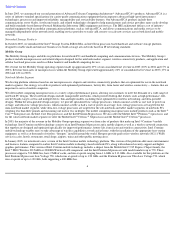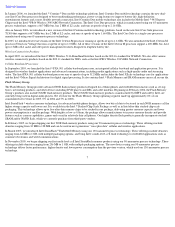Intel 2005 Annual Report Download - page 19
Download and view the complete annual report
Please find page 19 of the 2005 Intel annual report below. You can navigate through the pages in the report by either clicking on the pages listed below, or by using the keyword search tool below to find specific information within the annual report.
Table of Contents
Compliance with Environmental, Health and Safety Regulations
Intel is committed to achieving high standards of environmental quality and product safety, and strives to provide a safe and healthy workplace for our
employees, our contractors and the communities in which we do business. We have environmental, health and safety (EHS) policies and expectations
that are applied to our global operations. Each of Intel’s worldwide manufacturing and assembly and test sites is registered to the International
Organization for Standardization (ISO) 14001 environmental management system standard, which requires that a broad range of environmental
management processes and policies be in place to continually improve environmental performance, maintain compliance with environmental
regulations and communicate effectively with interested stakeholders. Intel’s internal environmental auditing program includes not only compliance
components, but also modules on business risk, environmental excellence and management systems. We have internal processes that focus on
minimizing and properly managing hazardous materials used in our facilities and products. We monitor regulatory and resource trends and set
company-wide short- and long-term performance targets for key resources and emissions. These targets address several parameters, including energy
and water use, climate change, waste recycling and emissions. Intel remains on track to achieve our voluntary commitment to reduce emissions of
certain global warming gases used in manufacturing by 10% from 1995 levels by 2010. Due to Intel’s increase in manufacturing since 1995, this will
equate to an actual reduction in 2010 of more than 90% from what Intel would have emitted without the voluntary reduction. We also continue to take
several actions to further our global energy reduction goal, such as investing in energy conservation projects in our factories and working with
suppliers of manufacturing tools to improve energy efficiency. We expect that these actions will result in energy cost savings and improved efficiency
in the use of electricity, natural gas and water. In addition, we have adopted water needs and reuse strategies that align with local community
expectations regardless of where we operate. As such, we continue to employ water use reduction strategies that seek to optimize the balance between
ultra-pure water needs and reuse options for industrial water.
As Moore’s Law drives increasing computing power year after year, managing the power consumption of the PC becomes an increasing challenge.
Intel has been a leader in developing innovative solutions to address and resolve power challenges. To be successful, Intel has taken a holistic
approach to power management, addressing the challenge at all levels, including the silicon, package, circuit, micro/macro architecture, platform and
software levels. A few examples include novel transistor and chip designs such as strained silicon and sleep transistors, Enhanced Intel SpeedStep
®
technology for mobile and desktop platforms, and Demand Based Switching (DBS) technology for server platforms.
The manufacture and assembly and testing of Intel products requires the use of hazardous materials that are subject to a broad array of EHS laws and
regulations. Intel actively monitors the hazardous materials that are used in the manufacture and assembly and testing of our products, particularly
materials that end up in the final product. Intel has developed specific restrictions on the content of certain hazardous materials in our products, as well
as those of our suppliers and outsourced manufacturers and subcontractors. Intel’s efforts to reduce hazardous substances in our products has
positioned us well to meet the various environmental restrictions on product content throughout the world, such as the Restriction on Hazardous
Substances (RoHS) directive in the European Union (EU). The RoHS directive eliminates most uses of lead, cadmium, hexavalent-
chromium, mercury
and certain fire retardants in electronics put on the market after July 1, 2006. Intel published its lead-free product roadmap in April 2004, and we
already manufacture and ship many products that are RoHS compliant (e.g., flash memory products; mobile, desktop, and server CPUs; chipsets;
network interface cards; wireless cards; and RoHS compliant platforms). Intel’s roadmap is designed to enable all Intel products sold into the EU to be
RoHS compliant before July 1, 2006. The State of California also has adopted restrictions on the use of certain materials in electronic products that are
intended to harmonize with the EU RoHS directive. Those restrictions go into effect in 2007. Other U.S. states are considering similar legislation.
Similarly, China has promulgated use restrictions on the same substances as the EU RoHS directive. China has not yet defined either the scope of
affected products or an effective date of the regulation. Intel is working with China’
s Ministry of Information Industry to promote consistency between
China’s use restrictions and the EU RoHS directive.
As Intel continues to advance process technology, the materials, technologies and products themselves become increasingly complex. Our evaluations
of new materials for use in R&D, manufacturing, and assembly and test take into account EHS considerations and are a component of Intel’s design
for EHS processes. Compliance with these complex laws and regulations, as well as internal voluntary programs, is integrated into our manufacturing
and assembly and test processes. To our knowledge, compliance with these laws and regulations has had no material effect on our operations.
Intel is committed to the protection of human rights and the environment throughout its supply chain. Intel expects suppliers to understand and fully
comply with all applicable international, national, state and local laws and regulations, including, but not limited to, all EHS and related laws and
regulations. In addition, suppliers are expected to abide by all Intel rules; maintain progressive employment practices; and comply with all applicable
laws including, at a minimum, those covering non-discrimination in the terms and conditions of employment, child labor, minimum wages, employee
benefits and work hours.
15
























